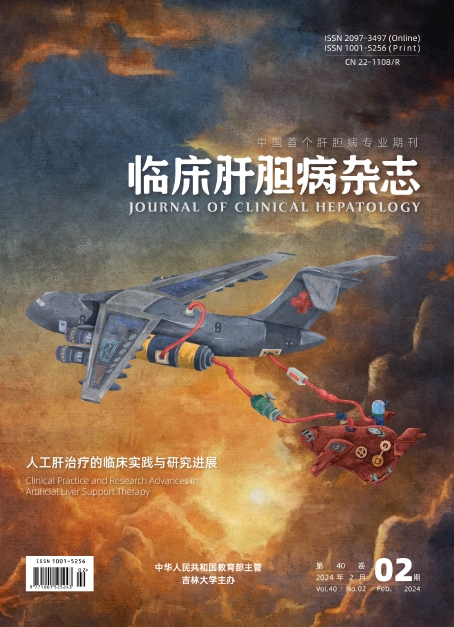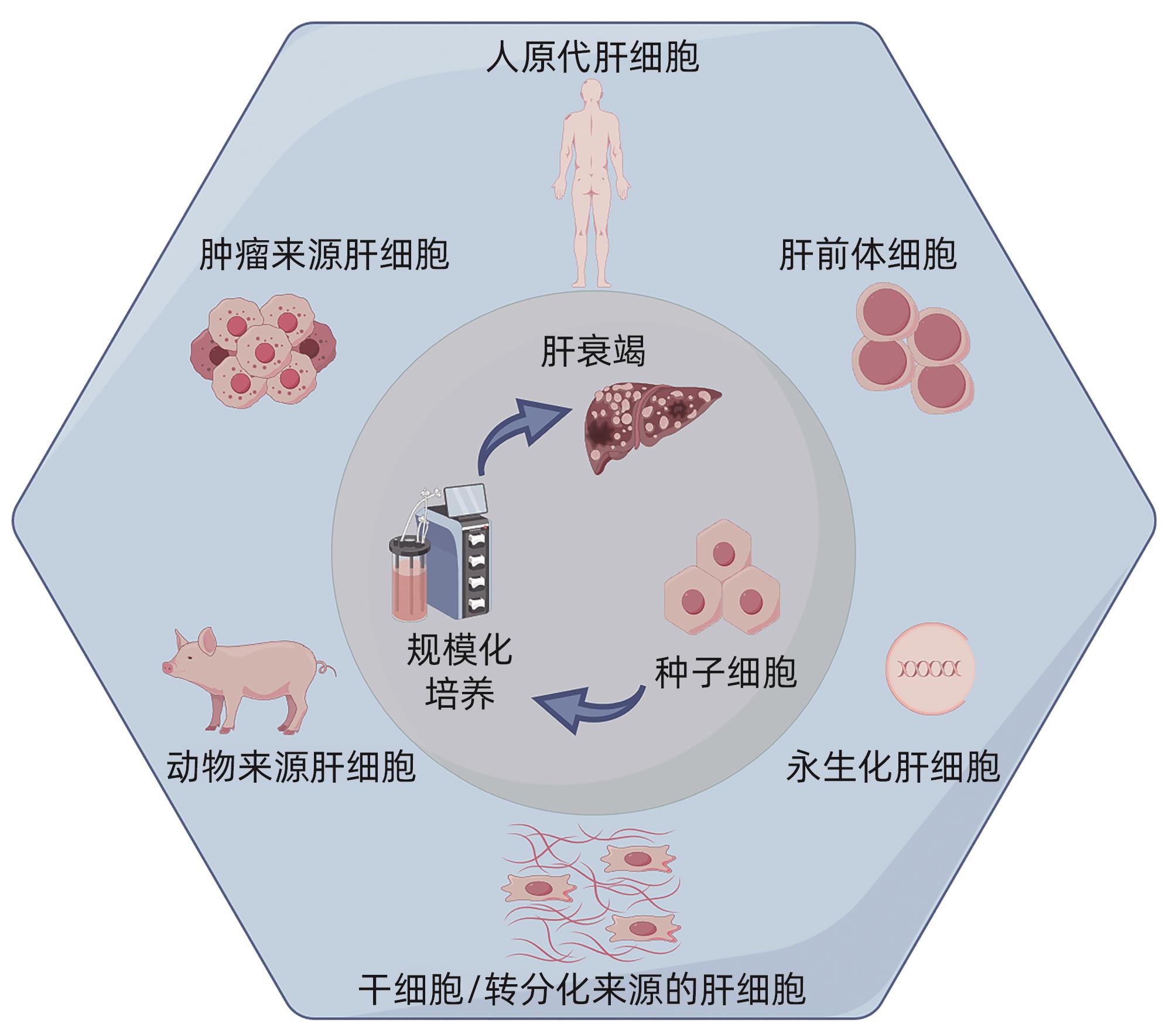| [1] |
PAN XP, LI LJ. Advances in cell sources of hepatocytes for bioartificial liver[J]. Hepatobiliary Pancreat Dis Int, 2012, 11( 6): 594- 605. DOI: 10.1016/s1499-3872(12)60230-6. |
| [2] |
DUAN ZP. Artificial liver technology and its progress[C]∥ Proceedings of the 10th National Military Infectious Disease Academic Symposium. 2007: 82- 84.
段钟平. 人工肝技术及其进展[C]∥ 全军第十次传染病学学术研讨会论文集. 2007: 82- 84.
|
| [3] |
GAO YM, SUN LL, HUI LJ. Advances in research of bioartificial liver[J]. Chin Bull Life Sci, 2016, 28( 8): 915- 920. DOI: 10.13376/j.cbls/2016123. |
| [4] |
TUERXUN K, HE JY, IBRAHIM I, et al. Bioartificial livers: A review of their design and manufacture[J]. Biofabrication, 2022, 14( 3): 032003. DOI: 10.1088/1758-5090/ac6e86. |
| [5] |
ROZGA J, UMEHARA Y, TROFIMENKO A, et al. A novel plasma filtration therapy for hepatic failure: Preclinical studies[J]. Ther Apher Dial, 2006, 10( 2): 138- 144. DOI: 10.1111/j.1744-9987.2006.00355.x. |
| [6] |
DETHLOFF T, TOFTENG F, FREDERIKSEN HJ, et al. Effect of Prometheus liver assist system on systemic hemodynamics in patients with cirrhosis: A randomized controlled study[J]. World J Gastroenterol, 2008, 14( 13): 2065- 2071. DOI: 10.3748/wjg.14.2065. |
| [7] |
MATSUMURA KN, GUEVARA GR, HUSTON H, et al. Hybrid bioartificial liver in hepatic failure: Preliminary clinical report[J]. Surgery, 1987, 101( 1): 99- 103.
|
| [8] |
GARCÍA MARTÍNEZ JJ, BENDJELID K. Artificial liver support systems: What is new over the last decade?[J]. Ann Intensive Care, 2018, 8( 1): 109. DOI: 10.1186/s13613-018-0453-z. |
| [9] |
Liver Failure and Artificial Liver Group, Chinese Society of Infectious Diseases, Chinese Medical Association; Severe Liver Disease and Artificial Liver Group, Chinese Society of Hepatology, Chinese Medical Association. Guideline for diagnosis and treatment of liver failure(2018)[J]. J Clin Hepatol, 2019, 35( 1): 38- 44. DOI: 10.3969/j.issn.1001-5256.2019.01.007. |
| [10] |
XIANG C, DU Y, MENG G, et al. Long-term functional maintenance of primary human hepatocytes in vitro[J]. Science, 2019, 364( 6438): 399- 402. DOI: 10.1126/science.aau7307. |
| [11] |
KATSUDA T, KAWAMATA M, INOUE A, et al. Long-term maintenance of functional primary human hepatocytes using small molecules[J]. FEBS Lett, 2020, 594( 1): 114- 125. DOI: 10.1002/1873-3468.13582. |
| [12] |
LIU MY, YANG JC, HU WJ, et al. Superior performance of co-cultured mesenchymal stem cells and hepatocytes in poly(lactic acid-glycolic acid) scaffolds for the treatment of acute liver failure[J]. Biomed Mater, 2016, 11( 1): 015008. DOI: 10.1088/1748-6041/11/1/015008. |
| [13] |
HARPER AM, ROSENDALE JD, MCBRIDE MA, et al. The UNOS OPTN waiting list and donor registry[J]. Clin Transpl, 1998: 73- 90.
|
| [14] |
FACCIOLI LAP, KOCAS-KILICARSLAN ZN, DIAZ-ARAGON R, et al. Human hepatocytes isolated from explanted livers: A powerful tool to understand end-stage liver disease and drug screening[J]. Organogenesis, 2021, 17( 3-4): 117- 125. DOI: 10.1080/15476278.2021.1992216. |
| [15] |
MIYAJIMA A, TANAKA M, ITOH T. Stem/progenitor cells in liver development, homeostasis, regeneration, and reprogramming[J]. Cell Stem Cell, 2014, 14( 5): 561- 574. DOI: 10.1016/j.stem.2014.04.010. |
| [16] |
TARLOW BD, PELZ C, NAUGLER WE, et al. Bipotential adult liver progenitors are derived from chronically injured mature hepatocytes[J]. Cell Stem Cell, 2014, 15( 5): 605- 618. DOI: 10.1016/j.stem.2014.09.008. |
| [17] |
FU GB, HUANG WJ, ZENG M, et al. Expansion and differentiation of human hepatocyte-derived liver progenitor-like cells and their use for the study of hepatotropic pathogens[J]. Cell Res, 2019, 29( 1): 8- 22. DOI: 10.1038/s41422-018-0103-x. |
| [18] |
CHEN Y, TANG D, WU HP, et al. Assessment of long-term functional maintenance of primary human hepatocytes to predict drug-induced hepatoxicity in vitro[J]. Arch Toxicol, 2021, 95( 7): 2431- 2442. DOI: 10.1007/s00204-021-03050-y. |
| [19] |
ZHANG K, ZHANG LD, LIU WM, et al. In vitro expansion of primary human hepatocytes with efficient liver repopulation capacity[J]. Cell Stem Cell, 2018, 23( 6): 806- 819. DOI: 10.1016/j.stem.2018.10.018. |
| [20] |
HU HL, GEHART H, ARTEGIANI B, et al. Long-term expansion of functional mouse and human hepatocytes as 3D organoids[J]. Cell, 2018, 175( 6): 1591- 1606. DOI: 10.1016/j.cell.2018.11.013. |
| [21] |
|
| [22] |
ZHANG YF, SHI J, LIU SY. Establishment and characterization of a telomerase-immortalized sheep trophoblast cell line[J]. Biomed Res Int, 2016, 2016: 5808575. DOI: 10.1155/2016/5808575. |
| [23] |
LU YZ, LI S, JIANG H, et al. Pre-clinical acute toxicity of an immortalized human hepatocyte cell line HepZJ[J]. Chin J Tissue Engineer Res, 2019, 23( 13): 2067- 2074. DOI: 10.3969/j.issn.2095-4344.1659. |
| [24] |
LI WJ, ZHU XJ, YUAN TJ, et al. An extracorporeal bioartificial liver embedded with 3D-layered human liver progenitor-like cells relieves acute liver failure in pigs[J]. Sci Transl Med, 2020, 12( 551): eaba5146. DOI: 10.1126/scitranslmed.aba5146. |
| [25] |
YANGER K, ZONG YW, MAGGS LR, et al. Robust cellular reprogramming occurs spontaneously during liver regeneration[J]. Genes Dev, 2013, 27( 7): 719- 724. DOI: 10.1101/gad.207803.112. |
| [26] |
DUAN YY, CATANA A, MENG Y, et al. Differentiation and enrichment of hepatocyte-like cells from human embryonic stem cells in vitro and in vivo[J]. Stem Cells Dayt Ohio, 2007, 25( 12): 3058- 3068. DOI: 10.1634/stemcells.2007-0291. |
| [27] |
WANG YF, ZHENG Q, SUN Z, et al. Reversal of liver failure using a bioartificial liver device implanted with clinical-grade human-induced hepatocytes[J]. Cell Stem Cell, 2023, 30( 5): 617- 631. DOI: 10.1016/j.stem.2023.03.013. |
| [28] |
TANG W, GUO R, SHEN SJ, et al. Chemical cocktails enable hepatic reprogramming of human urine-derived cells with a single transcription factor[J]. Acta Pharmacol Sin, 2019, 40( 5): 620- 629. DOI: 10.1038/s41401-018-0170-z. |
| [29] |
CHAMULEAU RAFM, DEURHOLT T, HOEKSTRA R. Which are the right cells to be used in a bioartificial liver?[J]. Metab Brain Dis, 2005, 20( 4): 327- 335. DOI: 10.1007/s11011-005-7914-4. |
| [30] |
COLTMAN NJ, COKE BA, CHATZI K, et al. Application of HepG2/C3A liver spheroids as a model system for genotoxicity studies[J]. Toxicol Lett, 2021, 345: 34- 45. DOI: 10.1016/j.toxlet.2021.04.004. |
| [31] |
ELLIS AJ, HUGHES RD, WENDON JA, et al. Pilot-controlled trial of the extracorporeal liver assist device in acute liver failure[J]. Hepatology, 1996, 24( 6): 1446- 1451. DOI: 10.1002/hep.510240625. |
| [32] |
THOMPSON J, JONES N, AL-KHAFAJI A, et al. Extracorporeal cellular therapy(ELAD) in severe alcoholic hepatitis: A multinational, prospective, controlled, randomized trial[J]. Liver Transpl, 2018, 24( 3): 380- 393. DOI: 10.1002/lt.24986. |
| [33] |
NAGAKI M, NAITO T, OHNISHI H, et al. Effects of plasma from patients with fulminant hepatic failure on function of primary rat hepatocytes in three-dimensional culture[J]. Liver Int, 2005, 25( 5): 1010- 1017. DOI: 10.1111/j.1478-3231.2005.01127.x. |
| [34] |
NIBOURG GAA, CHAMULEAU RAFM, VAN DER HOEVEN TV, et al. Liver progenitor cell line HepaRG differentiated in a bioartificial liver effectively supplies liver support to rats with acute liver failure[J]. PLoS One, 2012, 7( 6): e38778. DOI: 10.1371/journal.pone.0038778. |
| [35] |
GLORIOSO JM, MAO SA, RODYSILL B, et al. Pivotal preclinical trial of the spheroid reservoir bioartificial liver[J]. J Hepatol, 2015, 63( 2): 388- 398. DOI: 10.1016/j.jhep.2015.03.021. |
| [36] |
CHEN HS, JOO DJ, SHAHEEN M, et al. Randomized trial of spheroid reservoir bioartificial liver in porcine model of posthepatectomy liver failure[J]. Hepatology, 2019, 69( 1): 329- 342. DOI: 10.1002/hep.30184. |
| [37] |
HE YT, QI YN, ZHANG BQ, et al. Bioartificial liver support systems for acute liver failure: A systematic review and meta-analysis of the clinical and preclinical literature[J]. World J Gastroenterol, 2019, 25( 27): 3634- 3648. DOI: 10.3748/wjg.v25.i27.3634. |
| [38] |
LI Y, WU Q, WANG YJ, et al. Novel spheroid reservoir bioartificial liver improves survival of nonhuman primates in a toxin-induced model of acute liver failure[J]. Theranostics, 2018, 8( 20): 5562- 5574. DOI: 10.7150/thno.26540. |
| [39] |
MAZARIEGOS GV, KRAMER DJ, LOPEZ RC, et al. Safety observations in phase I clinical evaluation of the excorp medical bioartificial liver support system after the first four patients[J]. ASAIO J, 2001, 47( 5): 471- 475. DOI: 10.1097/00002480-200109000-00015. |
| [40] |
MULLON C, PITKIN Z. The HepatAssist bioartificial liver support system: Clinical study and pig hepatocyte process[J]. Expert Opin Investig Drugs, 1999, 8( 3): 229- 235. DOI: 10.1517/13543784.8.3.229. |
| [41] |
DEMETRIOU AA, BROWN RS JR, BUSUTTIL RW, et al. Prospective, randomized, multicenter, controlled trial of a bioartificial liver in treating acute liver failure[J]. Ann Surg, 2004, 239( 5): 660-667; discussion 667-670. DOI: 10.1097/01.sla.0000124298.74199.e5. |
| [42] |
MARTIN U, WINKLER ME, ID M, et al. Productive infection of primary human endothelial cells by pig endogenous retrovirus(PERV)[J]. Xenotransplantation, 2000, 7( 2): 138- 142. DOI: 10.1034/j.1399-3089.2000.00052.x. |
| [43] |
FENG L, WANG Y, FU Y, et al. A simple and efficient strategy for cell-based and cell-free-based therapies in acute liver failure: hUCMSCs bioartificial liver[J]. Bioeng Transl Med, 2023, 8( 5): e10552. DOI: 10.1002/btm2.10552. |
| [44] |
KNAZEK RA, GULLINO PM, KOHLER PO, et al. Cell culture on artificial capillaries: An approach to tissue growth in vitro[J]. Science, 1972, 178( 4056): 65- 67. DOI: 10.1126/science.178.4056.65. |
| [45] |
CASTILLO AB, JACOBS CR. Mesenchymal stem cell mechanobiology[J]. Curr Osteoporos Rep, 2010, 8( 2): 98- 104. DOI: 10.1007/s11914-010-0015-2. |
| [46] |
WANG Y, LI H, LI X, et al. Hypoxic preconditioning of human umbilical cord mesenchymal stem cells is an effective strategy for treating acute lung injury[J]. Stem Cells Dev, 2021, 30( 3): 128- 134. DOI: 10.1089/scd.2020.0174. |
| [47] |
CHEN ST, WANG JL, REN HZ, et al. Hepatic spheroids derived from human induced pluripotent stem cells in bio-artificial liver rescue porcine acute liver failure[J]. Cell Res, 2020, 30( 1): 95- 97. DOI: 10.1038/s41422-019-0261-5. |
| [48] |
LU ZY, PRIYA RAJAN SA, SONG QQ, et al. 3D scaffold-free microlivers with drug metabolic function generated by lineage-reprogrammed hepatocytes from human fibroblasts[J]. Biomaterials, 2021, 269: 120668. DOI: 10.1016/j.biomaterials.2021.120668. |
| [49] |
LIU WM, ZHOU X, CHEN CY, et al. Establishment of functional liver spheroids from human hepatocyte-derived liver progenitor-like cells for cell therapy[J]. Front Bioeng Biotechnol, 2021, 9: 738081. DOI: 10.3389/fbioe.2021.738081. |
| [50] |
LI K, ZHANG GH, ZHANG C, et al. Assessment of in vitro 3D large-scale hepatocyte proliferation culture system and automated and intelligent bioreactor systems[J]. Chin J Tissue Engineer Res, 2022, 26( 19): 3100- 3107.
李柯, 张广浩, 张丞, 等. 体外3D规模化扩增肝细胞的培养体系及自动化、智能化生物反应器的评估[J]. 中国组织工程研究, 2022, 26( 19): 3100- 3107.
|
| [51] |
TEIXEIRA AP, OLIVEIRA R, ALVES PM, et al. Advances in on-line monitoring and control of mammalian cell cultures: Supporting the PAT initiative[J]. Biotechnol Adv, 2009, 27( 6): 726- 732. DOI: 10.1016/j.biotechadv.2009.05.003. |
| [52] |
DEMUTH C, VARONIER J, JOSSEN V, et al. Novel probes for pH and dissolved oxygen measurements in cultivations from millilitre to benchtop scale[J]. Appl Microbiol Biotechnol, 2016, 100( 9): 3853- 3863. DOI: 10.1007/s00253-016-7412-0. |
| [53] |
RENNEBERG R, TROTT-KRIEGESKORTE G, LIETZ M, et al. Enzyme sensor-FIA-system for on-line monitoring of glucose, lactate and glutamine in animal cell cultures[J]. J Biotechnol, 1991, 21( 1-2): 173- 185. DOI: 10.1016/0168-1656(91)90269-2. |








 DownLoad:
DownLoad: